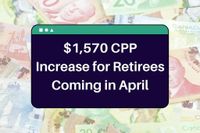As April 2025 approaches, Canadian seniors are gearing up for significant changes in their pension benefits, particularly under the Canada Pension Plan (CPP), Old Age Security (OAS), and the Guaranteed Income Supplement (GIS). These adjustments, which reflect a 2.7% increase due to cost-of-living adjustments (COLA), aim to help retirees keep pace with rising inflation and maintain their purchasing power.
According to the Canada Revenue Agency (CRA), the maximum monthly OAS payment for seniors aged 75 and older will rise to $800.44, while those aged between 65 and 74 will receive $727.67. This increase is part of a broader effort by the government to ensure that senior citizens can manage their living expenses effectively. The OAS benefits are adjusted quarterly based on the Consumer Price Index (CPI), which tracks inflation and the cost of living.
For those eligible for CPP, the maximum monthly payment will reach $1,433 starting in April 2025, representing a 2.7% increase from the previous year. This enhancement is part of the government's commitment to boost retirement income, with a goal of increasing the percentage of average earnings replaced by CPP benefits from 25% to 33.33% over time. Eligible individuals over the age of 65 will also see a 2.6% increase in their CPP benefits, bringing the maximum to $1,360.
In addition to OAS and CPP, many seniors will benefit from the GIS, which provides financial support to low-income seniors. For April to June 2025, single seniors can receive up to $1,086.88 under the GIS, while couples can receive around $1,357.50 combined. These payments are crucial for many seniors who rely heavily on government assistance to cover basic living expenses.
Despite the positive changes, there has been some confusion regarding claims of a $2,400 direct deposit for Canadian seniors in April 2025. While headlines may suggest such a figure, the CRA has not confirmed this amount. Instead, seniors should focus on the actual benefits they are entitled to receive through OAS, CPP, and GIS.
To clarify, the average monthly CPP payment for new recipients in April 2025 will be approximately $808.14, which is significantly lower than the combined figure often cited in misleading reports. It’s essential for seniors to rely on official government resources, like the CRA and Service Canada, to stay informed about their benefits and avoid falling for misinformation.
For seniors looking to apply for these benefits, the process is relatively straightforward. Applications for OAS and CPP can be submitted online through the My Service Canada Account or via paper forms. It is recommended to apply six months before turning 65 to ensure timely processing and avoid any delays in receiving benefits.
In addition to applying for OAS and CPP, seniors should also consider their eligibility for GIS, which requires them to be receiving OAS and have an income below a certain threshold. For instance, a couple where one partner receives full OAS must have a combined income below $52,848 to qualify for GIS.
As the April 28, 2025 payment date approaches, many seniors are reminded to ensure that their banking details are up to date with the CRA to facilitate direct deposits. This will help avoid any delays in receiving their payments.
It’s also important to note that while OAS and CPP benefits are taxable, GIS payments are not. This distinction can significantly affect a senior's overall income tax situation, making it vital for retirees to understand the implications of their benefits.
In summary, Canadian seniors can look forward to increased financial support through OAS, CPP, and GIS in April 2025. These enhancements are designed to help seniors cope with the rising cost of living and ensure they have the resources needed for a comfortable retirement. With careful planning and awareness of eligibility criteria, seniors can maximize their benefits and maintain their financial stability during retirement.









